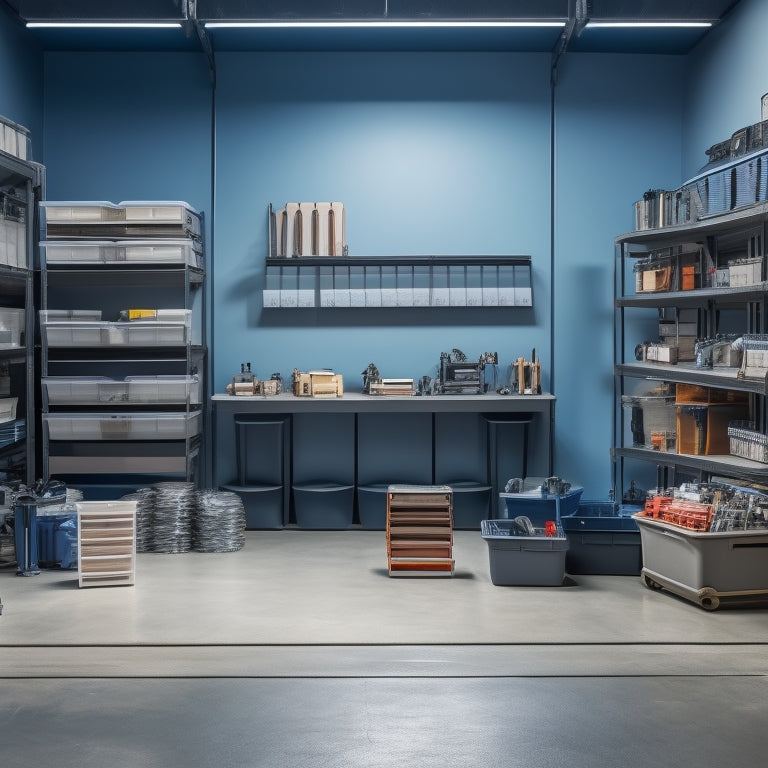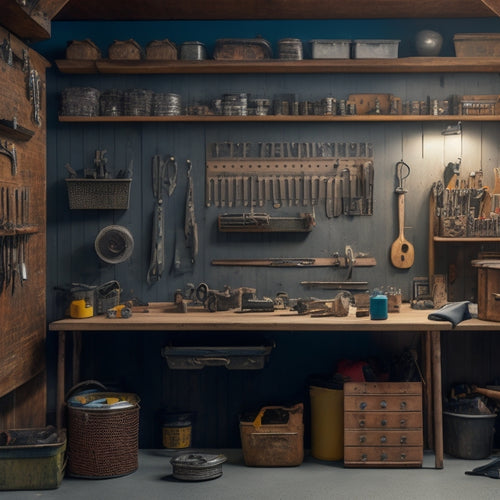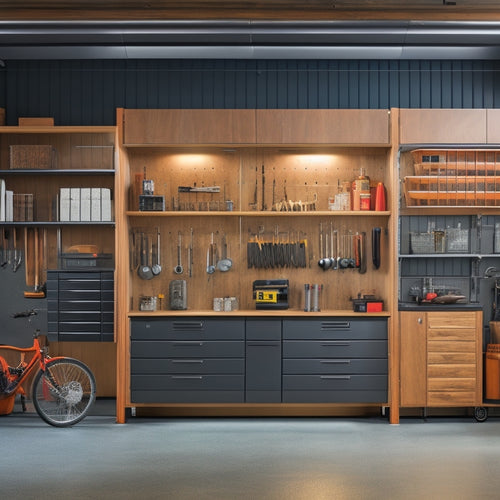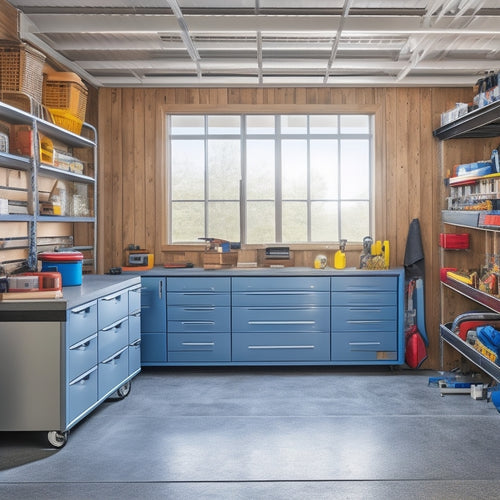
How to Maximize Storage Space With Parts Storage Bins
Share
To maximize storage space with parts storage bins, start by evaluating your available storage space and examining your layout for optimization opportunities. Choose the right bin size by considering item size and shape, and prioritize versatility with adjustable dividers. Effective labeling and organizing strategies will enhance access and productivity. Employ vertical storage options, designate zones for parts, and implement a first-in-first-out system to guarantee older items are used first. By following these steps, you'll be well on your way to creating a highly efficient storage system - and there's even more you can do to take your storage space to the next level.
Key Takeaways
- Assess available storage space by taking precise measurements and identifying bottlenecks to optimize layout and accessibility.
- Choose the right bin size based on item dimensions and shelf space, prioritizing versatility with adjustable dividers.
- Implement a color-coded organization system to provide instant visual cues, enhance accessibility, and reduce errors.
- Maximize vertical storage capacity without sacrificing floor space using wall-mounted solutions, overhead shelving, and tall cabinets.
- Establish clear inventory management rules, including FIFO practices, to ensure older items are used first and reduce waste.
Assessing Available Storage Space
Your storage space is unique, with its own set of dimensions, obstacles, and constraints. Before you start organizing with parts storage bins, it's crucial to assess the available space accurately.
Take precise measurements of the length, width, and height of your storage area, including any obstructions like pillars or pipes. Employ space measurement techniques like creating a scale drawing or taking photos to help you visualize the space.
Next, evaluate your storage layout to identify areas that can be optimized. Consider the flow of traffic, the frequency of access, and the types of items you'll be storing.
Ask yourself, "What are the most efficient ways to make use of this space?" and "What are the potential bottlenecks?" A thorough storage layout evaluation will help you determine the best placement for your parts storage bins, ensuring easy access and maximum storage capacity.
Choosing the Right Bin Size
With your storage space assessed and layout evaluated, you're now ready to select the perfect parts storage bins. The right bin size is essential to maximize storage capacity and guarantee easy access to your parts.
Consider the size and shape of the items you need to store and choose bins that accommodate them comfortably. Measure the available space on your shelves or racks to determine the maximum bin dimensions that will fit.
Bin shapes also play a significant role in optimizing storage. Rectangular bins are ideal for storing long, thin items like pipes or rods, while square bins are better suited for storing smaller, bulkier items like nuts and bolts.
Consider the height of your shelves and the weight capacity of your bins to guarantee they can hold the desired amount of inventory.
When selecting bin sizes, prioritize versatility and flexibility. Choose bins with adjustable dividers or compartments to accommodate different sizes and shapes of parts.
Labeling and Organizing Bins
You've got your bins, now it's time to make the most of them by labeling and organizing their contents. Effective bin labeling strategies can help you quickly identify what's inside, saving you time and frustration.
Bin Labeling Strategies
Effective bin labeling strategies are essential to maintaining a well-organized parts storage system. You'll want to choose a labeling method that's easy to read and understand, even in a fast-paced work environment. Consider the type of bin and the materials you're storing when selecting your labeling materials.
| Labeling Materials | Bin Types |
|---|---|
| Adhesive labels | Small parts bins, shelves, and cabinets |
| Laser-etched labels | Metal bins, racks, and containers |
| Color-coded stickers | Large bins, totes, and pallets |
When labeling your bins, be sure to include essential information such as the part number, description, and quantity. You can also add additional details like the storage location or the date the parts were received. Remember to keep your labels consistent with respect to format and design to make it easy to scan and identify the contents of each bin. By implementing a clear and concise labeling strategy, you'll be able to quickly locate the parts you need, reducing waste and increasing productivity.
Color-Coded Organization Systems
Implementing a color-coded organization system can revolutionize your parts storage operation by providing an instant visual cue for identifying specific bins and their contents. This system utilizes the power of color significance, visual impact, and color psychology to create an intuitive and efficient storage environment.
By assigning specific colors to different categories of parts, you can:
- Enhance accessibility and quick identification, reducing the time spent searching for specific components
- Create an aesthetically pleasing and organized workspace, improving emotional response and overall job satisfaction
- Increase sorting efficiency and reduce errors, as the color-coded system helps you quickly distinguish between similar-looking parts
Furthermore, color-coded organization systems can be customized to fit your brand's identity, incorporating seasonal themes or unique design elements to enhance brand differentiation.
Utilizing Vertical Storage Options
How can you make the most of your available floor space while keeping your parts and supplies organized? By utilizing vertical storage options, you can maximize your storage capacity without sacrificing essential floor space.
Consider installing wall-mounted solutions, such as pegboard installations or hanging bins, to store frequently used items within easy reach. Overhead shelving and vertical racks can be used to store less frequently used items, keeping them out of the way but still accessible.
Ladder storage can be used to access high shelves, ensuring safe retrieval of items. Stackable containers and modular shelving can be used to store bulk items, while sliding shelves can be used to store items that need to be accessed frequently.
Tall cabinets can be used to store items that require more security or protection from the environment. By utilizing these vertical storage options, you can create a more organized, efficient, and safe storage space that makes the most of your available floor space.
Designating Zones for Parts
You generally organize your parts and supplies by function or category to optimize your storage space and workflow. This is where designating zones for parts comes into play. By creating specific zones for different types of parts, you can improve spatial planning and reduce the risk of misplacement or accidents.
To create effective zones, consider the following:
-
Identify high-traffic areas: Place frequently used parts in easily accessible zones to reduce congestion and improve workflow.
-
Group similar parts together: Store parts with similar functions or characteristics in the same zone to simplify inventory management and reduce search time.
-
Label each zone clearly: Use clear and concise labels to guarantee that everyone in the workspace can quickly identify the contents of each zone.
Implementing a First-In-First-Out System
When implementing a first-in-first-out system, you'll need to develop strategies for bin rotation, establish clear inventory management rules, and prioritize your stock to guarantee that older items are used before newer ones.
This approach will help you avoid expired or obsolete parts, reduce waste, and optimize your storage space.
Bin Rotation Strategies
Effective inventory management relies on a well-organized system, and bin rotation strategies play an essential role in maintaining a tidy and efficient parts storage setup.
By implementing a well-thought-out bin rotation strategy, you'll guarantee that your parts storage bins remain organized, and you'll be able to easily locate the parts you need when you need them.
To maximize the effectiveness of your bin rotation strategy, consider the following techniques:
-
Label and date bins: Clearly label each bin with its contents and the date it was stored, making it easy to identify which parts are oldest and should be used first.
-
Use bin accessibility techniques: Position bins in a way that allows easy access to the oldest parts, and consider using vertical shelving to maximize storage space.
-
Implement seasonal rotation methods: Rotate bins seasonally to guarantee that parts that are only used during certain times of the year are stored in a way that makes them easily accessible when needed.
Inventory Management Rules
Inventory management rules form the backbone of a well-organized parts storage system, and implementing a first-in-first-out (FIFO) system is a crucial aspect of these rules. By following this system, you guarantee that the oldest items in your inventory are used or sold before newer ones, reducing the risk of expired or obsolete parts.
To maintain a FIFO system, you'll need to regularly conduct stock counting and inventory audits to track the movement of your parts. This involves counting the quantity of each item, checking expiration dates, and identifying slow-moving or dead stock. By doing so, you'll be able to identify areas where you can optimize your storage space and reduce waste.
Additionally, a FIFO system helps you to detect any discrepancies in your inventory, allowing you to take corrective action promptly. By implementing these inventory management rules, you'll be able to maximize your storage space, reduce costs, and improve overall efficiency.
Stock Prioritization Methods
Sort through your parts inventory and identify the items that need to take priority. This is essential in implementing a first-in-first-out (FIFO) system, where the oldest items are sold or used first.
This approach helps maintain a healthy stock turnover, reducing the risk of expired or obsolete parts.
To prioritize your stock effectively, consider the following factors:
-
Demand forecasting: Identify which parts are in high demand and need to be replenished regularly.
-
Expiration dates: Verify that perishable items, such as chemicals or batteries, are used before their expiration dates.
-
Shelf life: Prioritize items with a shorter shelf life, such as electronics or mechanical components, to minimize the risk of damage or degradation.
Rotating and Refreshing Inventory
Cluttered shelves and disorganized bins can quickly become a thing of the past when you implement a rotating and rejuvenating inventory system. To maximize storage space, you'll need to prioritize inventory turnover, making room for fresh stock and reducing waste.
Make seasonal adjustments to your inventory to account for changes in demand, and use demand forecasting to inform your stock replenishment strategies.
Regular inventory audits help you identify slow-moving or dead stock, which can be cleared out to make way for more in-demand items. This not only frees up space but also reduces waste and saves you money.
By streamlining your supply chain and implementing efficient stock replenishment processes, you'll be able to respond quickly to changes in demand and stay ahead of the competition.
Don't forget to incorporate promotional strategies into your inventory rotation plan. By offering discounts or promotions on slow-moving items, you can clear out space and make room for new stock.
Maintaining Cleanliness and Order
By streamlining your inventory rotation, you're already halfway to maximizing your storage space.
Now, it's crucial to maintain cleanliness and order to guarantee your parts storage bins continue to function efficiently. A clean and organized storage area prevents damage to parts, reduces the risk of accidents, and saves you time searching for misplaced items.
To maintain cleanliness and order, establish the following routines:
-
Create a cleaning schedule: Set aside time each week to dust and vacuum your storage area, and deep clean your parts storage bins every quarter.
-
Designate a "home" for each item: Assign a specific bin or shelf for each part or tool, making it easier to find what you need and preventing clutter from building up.
-
Conduct regular inventory audits: Regularly review your inventory levels and remove any expired, damaged, or obsolete parts to free up space and reduce waste.
Frequently Asked Questions
Can Parts Storage Bins Be Used for Outdoor Storage?
You can definitely use parts storage bins for outdoor storage, but make sure they're designed with outdoor durability and weather resistance in mind, featuring waterproof materials and UV protection to keep your items safe from the elements.
How Often Should Inventory Be Rotated and Refreshed?
You should rotate and refresh your inventory regularly to guarantee it remains relevant and accessible, implementing effective inventory management strategies that prioritize the benefits of rotation, like reduced waste and improved safety, every 3-6 months.
Are Clear Bins Better Than Opaque Bins for Visibility?
When choosing storage bins, you'll find clear bins offer better visibility benefits, allowing you to quickly identify contents, whereas opaque bins may hide damage or contamination; however, opaque bins often provide better material durability against scratches and fading.
Can Parts Storage Bins Be Mounted on Walls or Ceilings?
In ancient Rome, builders maximized space with clever storage solutions. You can do the same by installing wall-mounted bins and ceiling storage, keeping parts organized, easily accessible, and out of the way, while ensuring a safe and clutter-free workspace.
Are There Specific Bins for Storing Small or Fragile Parts?
You'll find specialized bins designed specifically for storing small parts and fragile items, offering additional protection and organization. Look for bins with dividers, compartments, or soft lining to keep delicate components safe and prevent damage.
Conclusion
You've optimized your storage space with parts storage bins, and now you're ready to reap the benefits. Don't worry if you think you'll forget where everything is - with labeled bins and designated zones, you'll quickly find what you need. And yes, it might take some effort to maintain, but the time you'll save in the long run will be well worth it. By following these simple steps, you'll be able to focus on more important things, like growing your business or tackling your next project.
Related Posts
-

Design Considerations for a Custom Pegboard
When designing a custom pegboard, you'll want to start by evaluating your storage needs, considering factors like too...
-

Best Materials for Garage Wall-Mounted Cabinets
When selecting materials for your garage wall-mounted cabinets, you'll want to evaluate options that balance durabili...
-

Top Rolling Tool Box Drawers for Maximum Storage
When it comes to maximizing storage with rolling tool box drawers, you need a solution that combines durability, cust...


